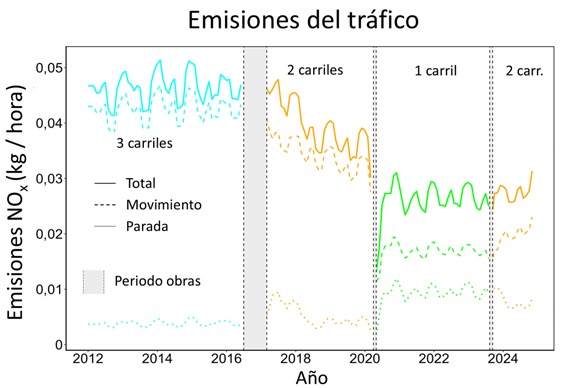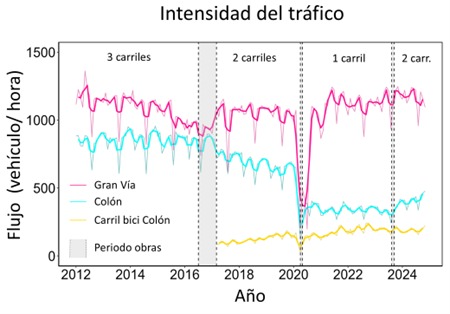Researchers at the ITACA Institute of the Universitat Politècnica de València (UPV) have determined that reducing the number of lanes open to general traffic results in a clear progressive decrease in traffic and a reduction in emissions of gases harmful to health, such as nitrogen oxides (NOx) both in the affected area and in neighbouring areas.
The study, carried out by the ICTs Against Climate Change research group, was led by Professor José Vicente Oliver, together with Victoria Lerma, Edgar Lorenzo, David Fuente and Helena van den Berg. The work monitored the volume of traffic and gas emissions on one of the busiest roads in the city of Valencia, Colón Street, with data from 2012 to 2024.
According to the UPV team, before the first road reduction undertaken in 2016, Colón Street was one of the main arteries for road traffic in the centre of Valencia, used not only to move around the centre but also as a connecting road leading out to the south and west of the city. Traffic on this street was intense, with values ranging from 1,200 to 1,500 vehicles per hour during peak hours.
In 2016, Calle Colón went from having three general traffic lanes to two due to implementing a bike lane. With this measure, the average number of vehicles dropped to 850 per hour. In 2020, during the COVID-19 lockdown, a second intervention was implemented to replace another lane with one for taxis and buses.
Access directly through the Porta de la Mar was restricted, leaving only one lane for cars and motorbikes. Consequently, between 2020 and 2023, traffic intensity fell dramatically to 350 vehicles per hour, with only one lane available, representing a decrease of almost 60% compared to the configuration with three general lanes. At the same time, the alternative route along Gran Vía Marqués del Turia experienced less than 5% growth in traffic intensity (see Figure 1).

In the words of Edgar Lorenzo, ‘the case of Colón Street is representative and paradigmatic for the city of Valencia. Active traffic reduction policies, although they may generate an increase in congestion at certain points, have a direct and positive impact on reducing polluting emissions by reducing the total number of vehicles in circulation’.
Emissions in motion and at a standstill
The study determines that, although the reduction of lanes can increase traffic congestion, this increase in stationary emissions was less than the savings in emissions from vehicles in circulation, thanks to the drastic decrease in the flow of vehicles.
Before the reduction in lanes, total emissions ranged between 0.04 and 0.05 kg of nitrogen oxide per hour (NOx). However, these were reduced by more than 40% with the single lane available. It should be noted that this reduction in total emissions occurred despite the increase in emissions at a standstill, which increased from three (before 2016) to one available lane (from 2020 to 2023).
Reintroduction of a second lane and increased traffic intensity
At the end of 2023, one of the two bus lanes was reversed and replaced by a second lane for general traffic and access to Colón Street was allowed through the Porta de la Mar entrance. As a result, traffic intensity has increased considerably in the last year. In fact, the flow of vehicles has increased by approximately 35% between November 2023 and November 2024. Likewise, total NOx emissions rose by almost 20% in the same period (see Figure 2).

Meanwhile, the alternative route along Gran Vía Marqués del Turia has not reduced the traffic intensity or polluting emissions on this avenue.
‘The results show that it is time to commit decisively to Low Emission Zones (LEZs) and measures focused primarily and as a priority on the health of citizens and the urban environment’, explained Professor Victoria Lerma.
The results of this study are part of the PREDATICS project, which aims to predict and issue health alerts in episodes of high air pollution through the development of a digital system based on satellite data by remote sensing, terrestrial sensors and predictive models using artificial intelligence (AI).



